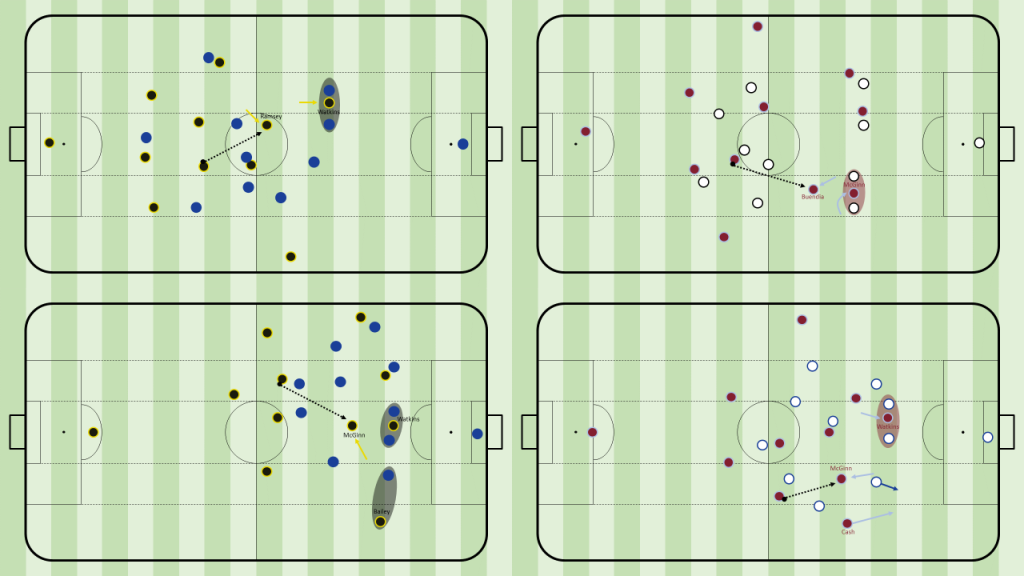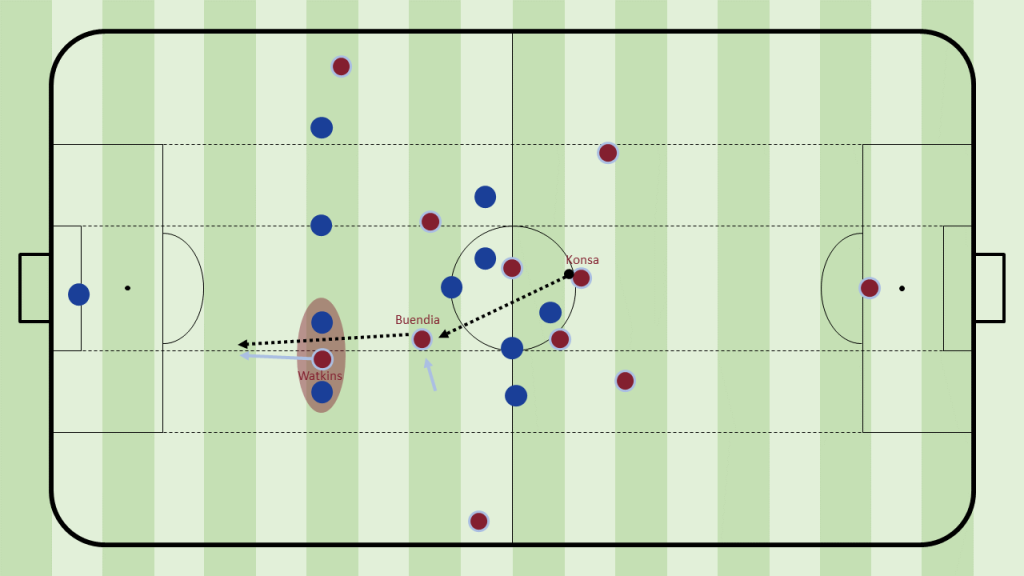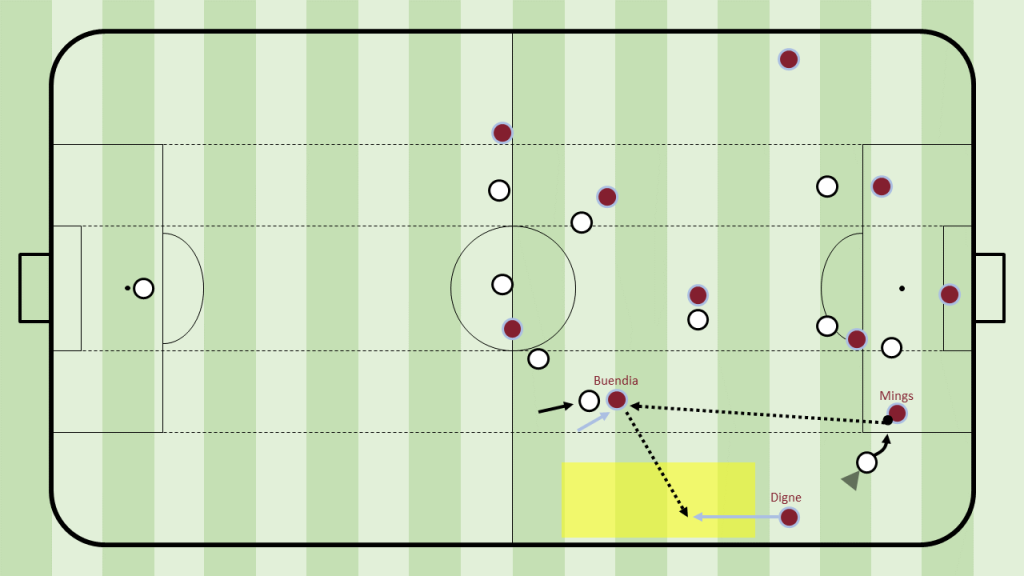Positional superiority, dynamical space occupation and movements in behind – how Unai Emery turned the Villains into European football contenders by improving his forwards.
Introduction
After taking over from Steven Gerrard, Aston Villa had a shocking start to the season and was near the relegation zone. The Frenchman however brought the Villains up the table extremely quickly. They currently rank 7th and are in the fight for the European places.
Unai Emery in particular improved his forwards. Emiliano Buendia for example, who wasn’t a regular starter under Gerrard, is now shining and a key figure in Aston Villa’s possession game alongside the Englishman Jacob Ramsey. Additionally, Ollie Watkins is thriving and turned into one of the best strikers in the league.
So, how did Unai Emery transform Aston Villa’s forwards?
Shape in possession
To begin with, Aston Villa uses a 4-2-2-2/4-2-3-1 from the goal kick with deep fullbacks and wingers, who invert into the half-spaces to create a midfield box. The double pivot is positioned narrow to not close passing lanes into the half-spaces. When slowly progressing up the field, this structure can transition into other shapes, depending on the player profiles. Villa recently opted for an asymmetric 3-2-5 with Moreno, the left back advancing and occupying the wide channel. Young (right back) is then positioned deeper to form a back three. Moreover, the left winger inverts and Bailey on the right moves wide (usually from the striker position). This leads to Watkins being the sole striker, while both Buendia and Ramsey occupy the half-spaces in between the lines, where they are so effective. However, when Cash is lined-up as the right back, he usually moves up like Moreno to join the attacking line from time to time as well. Additionally, another variation occurs when Buendia is initially the second striker besides Watkins. The Argentinian then still moves into the half-space, while the right winger occupies the right channel.

In the end, what’s important is that two players constantly occupy spaces in between the opposition’s midfield and defensive line (usually the wingers in the half-spaces) and the other attackers/fullbacks pin the opponent’s backline.
Nevertheless, what really makes this system so effective are the different positionings and movements of the forwards. The aim from Aston Villa is to access a player in between the lines (usually Buendia or Ramsey) to then speed up the attack and exploit the depth with runners in behind (especially through Watkins).
Finding a player between the lines
When building up from the back, the Villains look to attract pressure to increase the space in between the lines and eventually aim to access this created gap.
Emiliano Martinez is regularly incorporated in Aston Villa’s build-up sequences to ensure numerical superiority. His clipped balls into the fullbacks especially are vital for Villa’s progression. After the wide defenders receive in space, they’ll dribble into it and then look for a forward from this different angle either to feet or in behind.
Furthermore, the double pivot is used for third man combinations to access a spare man with a forward-facing view (usually a centre back), who then has the capabilities of playing in between the lines with a higher accuracy since he is given more time and space. Similar to De Zerbi’s Brighton, the dropping movements of the sixes are vital to both create separation from their direct markers but also increase the space between the opposition’s midfield and defensive line by dragging opponents higher up the pitch. In addition, if a 6 receives in space himself, he’ll turn and aim for a player between the lines or play directly in behind.

Of immense importance is the timing of the line-breaking pass. Too early and another opponent might intercept the ball or too late and the receiver is directly under pressure. Villa tries to not force these passes but rather circulate possession, invite pressure again and wait for new openings if the pass is currently not possible.
The players in between the lines (initially being positioned in the half-spaces) can also regularly occupy different spaces with horizontal movements depending on the opposition but also to receive with separation and create a dilemma for the defenders. This dynamical space occupation requires a lot of communication from the opposition and makes them harder to mark. Important is that they are accessible and not cut out of any cover-shadows from the opponent. Buendia in particular moves a lot in between the lines and can temporarily occupy the other half-space as well or stay centrally behind Watkins as a number 10. Moreover, the players regularly deploy short double movements to create more space for themselves by faking a run in behind before quickly changing the direction.
Difficult to mark are also movements in the opposite direction of the defence. The player then receives with a dynamical advantage since the opponents can’t adapt so quickly as they are just moving in a different direction.

To even enable these extensive movements by the players in between the lines, it’s vital that the opposition’s backline is pinned back (just as in the illustration above). Especially Watkins’ runs in behind or horizontal evasive movements (regularly in combination with the winger moving inside as a horizontal rotation) restrict centre backs or fullbacks from moving up and push the defensive line deep to increase the space in between the lines.
It’s not uncommon either that Watkins is positioned in between a fullback and a centre back with a winger right in front of him on the same vertical channel. One might argue that these occupations aren’t beneficial as the winger effectively takes out Watkins as a passing option with his own cover-shadow. However, the aim is to find a winger in between the lines first and Watkins’ main task is to stay on the last line rather than receiving a ball to his feet.
Moreover, it can also be an overlapping fullback, who might dynamically pin a player with his higher positioning and enable a winger to drop in between the lines without an opponent behind his back.

If an opposing defender would decide to step up on a player in between the lines, he risks leaving a gap in the defensive line, which the “pinning players” can directly exploit through movements in behind. Nevertheless, with an opponent behind his back, it’s vital that the receiver in between the lines from Aston Villa is supported with lay-off options, who can then find runners with their forward-facing views.
The opposition is therefore always at a disadvantage. If the defenders decide to step up, space is generated in behind. If the defenders decide to remain deep, the players in between the lines can receive freely. This phenomenon is also known as “positional superiority”.

Even though Watkins mainly stays on the last line to restrict the defenders from moving up or he runs in behind when space is created, he can still drop shortly to provide a passing option and may then find a free player from this different angle by laying the ball off.
Exploiting the space in behind
The end goal of Aston Villa’s attacks however is to exploit the space in behind with a dynamical advantage and ideally score a goal from this situation.
When a player receives freely in between the lines, he’ll turn and look for runners in behind as quickly as possible. This player may also at times dribble a few metres to allow his teammates to position themselves accordingly and wait for the right timing to release the ball.

Ollie Watkins’ is normally the target with his movements in behind due to his speed and physical strength but obviously also his shooting abilities. After a teammate gets the ball in between the lines and turns, Watkins instantly tries to position himself on the blind-side of his direct opposition (creating a diagonal angle between him and the passer) and generate a slight separation from his marker. He often makes curved runs, which enable him to create a dynamical advantage while staying onside.
The timing of the run and the pass are once again key. The attackers (not just Watkins) ideally start their runs as soon as the ball-carrier looks up. This enables the forwards to gain momentum and reach a higher speed earlier than their (mostly static) opponents, who can only react or at least anticipate these movements.

It’s brilliant to see how the Villa attackers in general are willing to consistently run in behind despite (obviously) not receiving every ball. The players understand that each movement challenges the opposition’s backline and forces them to react. Moreover, runs in behind can create depth and increase the space in between the lines even more. Additionally, these movements may also act as a decoy and drag defenders away to open spaces elsewhere. To work as such, it’s vital that the run is threatening, and the player has a potential chance to get on the ball.
Especially when attacking crosses in the opposition’s penalty area, Aston Villa implements opposite movements or decoy runs to create space and disturb the opposition as well.

Wide chance creation methods
Other than creating chances through the centre, Villa regularly uses the wide areas to exploit spaces there as well. Especially Moreno and Digne on the left or (if deployed) Cash on the right frequently provide overlaps and occupy the last line.
They continuously break through with a dynamical advantage as they start their runs earlier than their direct opponents (ideally on the blind-side). The opposition’s fullback is then often underloaded (1v2) and has to decide between following the winger in between the lines/inside or staying deeper to defend the overlap. If the opponent moves with Aston Villa’s wide forward, the wing is left open for the fullback to exploit, or another player (usually Watkins) can attack the gap in behind. If the opposing wide defender chooses to remain deep, the Villains’ winger can receive freely. Once again, a lose-lose situation for the opponent and positional superiority for Villa.

By creating these 2v1s, the fullback’s high positioning might even lead to the opposition’s fullback to stay wider (having a shorter distance to the Aston Villa fullback if he receives), which then increases the space between the opponent’s wide defender and the centre back for the Villains to exploit with runs in behind.
The direct approach
Nevertheless, the Villains also struggle at times under pressure and use a more direct approach as an alternative to access a forward or exploit the depth. In particular, if the fullbacks receive the ball under heavy pressure, they often don’t hesitate and simply clip the ball forward into their respective wingers or another forward.
If the centre backs or 6s are given time and space, they frequently play a long ball in behind into a runner directly. Crucial are the consistent vertical counter-movements and double movements to disturb the backline, generate separation and create space in behind. The timing for a run in behind is once again as soon as the ball-carrier looks up.
When Villa decides to go long, it’s key that the target (usually Watkins) is well-supported with lay-off options (which is also induced because of their shape in possession, placing a high focus on the centre). This in turn enables the Villains to win a potential 2nd ball easier if the target doesn’t win the initial aerial duel. After Aston Villa could control the ball successfully from the long ball, they’ll quickly look for runners in behind once again or combine through.

Conclusion
Since taking over from Steven Gerrard, Unai Emery’s Villains registered the third highest points in the Premier League (only behind Manchester City and Arsenal). An incredible achievement! Nevertheless, when looking at the expected Points, there’s a completely different picture. Since Emery’s reign, Aston Villa was expected to make 29 Points, which would place them ninth. When taking into account each game under the Frenchman (something Jon Mackenzie did in his brilliant video), it’s visible that the Villains were often pretty lucky with the outcome of their matches. This xG overperformance won’t hold on forever and Aston Villa probably isn’t the third best team in the League (as their points under Emery would indicate).
Nevertheless, the improvements both with and without the ball under the Frenchman are undeniable. The Villains are now deservingly far away from the relegation zone, and it’ll be interesting to see where they’ll eventually end up on the Premier League table.
If you have any questions, please do not hesitate to contact us.



